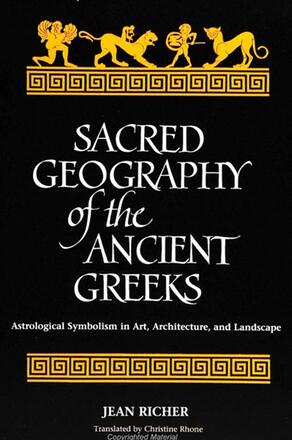List of Maps
Foreword
Translator's Preface
Preface
Chapter 1. Theory of Alignments
1. Delphi: Apollo and Athena
2. The Meridian of Delphi: Tempe-Delphi-Sparta-Cape Taenarum
3. Bassac, Tegea, Corinth
4. From Crete to Hyperborea
5. Leucas
6. The Four Temples of Hermione
7. The Oracle of Ptoon
8. The Apparently "Abnormal" Orientations of Temples: Bassae, Delos
Chapter 2. Interpretation of the Alignments. The Zodiacal Wheel Centered on Delphi. A Text of Plato's
1. Cephallenia or Aries
2. "Cow-eyed" Hera. Olympia
3. Gemini and Sparta
4. Cancer and the Moon
5. Leo, the Solar Sign
6. Athens, Delos, and the Sign of Virgo
7. Libra, Harmonia, and Thebes
8. Scorpio or the Eagle
9. The Land of the Centaurs: Chiron the Sagittarian
10. Capricorn and Hyperborea
11. Aquarius
12. Pisces. Cassiopeia
13. A Text of Plato's
Chapter 3. The System Centered on Delos
1. The Zodiacal Division
2. The Signs
3. Delphi and Delos
4. Delphi and Sardis
Chapter 4. An Anatolian System Centered on Sardis
1. The Omphalos of Sardis
2. The Zodiacal Wheel Centered on Sardis: the Signs
3. The Three Zodiacal Wheels of the Aegean
Chapter 5. The Constellations, Return to Delphi. Demeter, Artemis, and Athena
1. Ursa Major: Artemis, Brauron
2. Ursa Minor
3. Return to Delphi: the Agrenon
4. Demeter-Gemeter
5. Artemis
6. Brauron, Ephesus, and the Cave of the Bear
7. Athena
Chapter 6. The World Axis and the Planetary Lines. Symbols of the Pole
1. The Gateways of the Solstices
2. The Descent of Souls: from Taenarum to Delphi
3. The Ascent of Souls: from Delphi to Olympus
4. World Axes and Planetary Lines in the Systems of Delos and Sardis
5. The Nonzodiacal Constellations and Symbols of the Pole
6. The Boar, Symbol of the Pole; the Oath on the Boar
Chapter 7. The Zodiacal Division of Attica and the Mysteries: Agrae and Eleusis
1. The Zodiacal Division
2. The Mysteries: Agrae and Eleusis
3. An Unusual Monument
Chapter 8. Zodiacal Wheels as Keys to Decoding. The Gods and the Zodiac
1. The Homeric Hymn to Hermes
2. Hermes and Athens: the Charites; Cephalus
3. The Homeric Hymn to Aphrodite
4. Hephaestus. Scorpio. The Journey of Sacrifices. The Sacrifices. Sexual Magic
5. Poseidon, the Horse-god, and the Sign of Gemini
Chapter 9. The Cult of Zeus. Sardis, Delphi, and the Oasis of Siwa. A System Centered on Ammoneion
1. Sites of the Cult of Zeus
2. The Sardis-Delphi-Ammoneion Triangle
3. Myths and Monuments Confirming the Existence of this System
4. The Legend of Ammon and the Ritual of the Oracle
Chapter 10. The Calendars of Heracles. Guardians of the Signs
1. Heracles and the Peloponnese: the System Centered on Phlius
2. The Ancient Guardians of the Zodiac ("Hesiodic Guardians")
3. Heracles and Omphale
4. A More General System. The Directions of Space
5. Vestiges of an Earlier Zodiac in the Legend of Heracles; the Sign of the Boar
6. Heracles and Apollo
Chapter 11. The Astral Significance of Greek Myths and Heroes
1. Myths and Rites of the Spring Equinox
2. Castor and Pollux
3. Helen and Cancer
4. The Cancer-Capricorn Axis: Zeus and Typhon
5. Orion and the Taurus-Scorpio Axis
6. Cadmus and Harmonia or Scorpio and Libra
7. Perseus, Solar Hero and Champion of Athena
8. Bellerophon, Corinth, and Lycia
9. The Heroic Deeds of Theseus
10. The Heroes of Sagittarius
Chapter 12. The Revelation of the Lion of Julis
1. The Lion of Julis
2. The Coins of Kea, the Dog and the Dog-days, the Bull
3. The Alpheus or Taurus, the Elaphe
4. Aristaeus
5. A Significant Rectangle
6. A Rectangle Centered on Sardis
Chapter 13. Fixed Symbols of the Signs, Directions, and Seasons. The Loves of Zeus
1. The Fixed Symbols of the Directions of Space: the Cycles of Four Animals
2. The Loves of Zeus
Chapter 14. Double Symbols. Syncretic Forms. Fighting Animals, Dynamic Symbols of Seasonal Variations. The Calendar of Xanthus
1. Double Symbols
2. A Syncretic Form: the Hippalectryon
3. Other Syncretic Forms
4. Associations of Zodiacal Symbols
5. Dynamic Symbols of Seasonal Variations
6. The Calendar of the Acropolis of Xanthus
Chapter 15. Shield Devices. The Commons Origins of Blazons and Monetary Symbols. The Complementarity of Opposites. Plaques from Delphi. Study of Vases
1. Shield Devices
2. The Complementarity of Opposites. The Lesson of the Vases
3. Symbolic Scenes Showing Zodiacal Oppositions: Plaques Found at Delphi
4. Zodiacal Aspects on Vases. Principles of Interpretation. Oppositions and Squares
5. The Vases of Exekias
6. Images of the Solstices and the Equinoxes onVases
7. A Corinthian Aryballus of Astrological Design
8. Symbolic Formulas
Chapter 16. The Horoscopic Meaning of the Armlets of Shields
Chapter 17. Greek Temples: Sculpted Pediments and Zodiacal Geography. The Structure of Sanctuaries
1. Corfu and Athens
2. Temples of the Delphic System
3. Delphi: the Pediments of the Temple of the Alcmaeonidae
4. Delos: the Pediments of the Temple of the Athenians
5. The Pediment of the Hydra at Athens
6. Temples in the Phlius System: Tegea and Calydon
7. Bassac
8. Olympia
9. The Temple of Hera at Samothrace: the Structure of the Sanctuary and the Pediment; Victory and the Ship
Chapter 18. Greek Temples of Asia Minor. The Decor of the Temple of Assos in the Troad
1. Didyma and Bassae
2. The Decor of the Temple of Assos in the Troad
3. Conclusions
4. Symbolic Formulas
Chapter 19. The Delphic Oracle and Colonization. Animal Guides. The Trojan Horse
1. The Oracle and Significant Alignments
2. Animal Guides
3. The Trojan Horse
Chapter 20. Zodiacal Imagery at Mycenae. The Great Uranian Goddess. The Inquiry Continues
1. Zodiacal Imagery at Mycenae
2. The Great Goddess
3. The Handles of Hydrias
4. The Inquiry Continues
Abbreviations
Notes
Index
